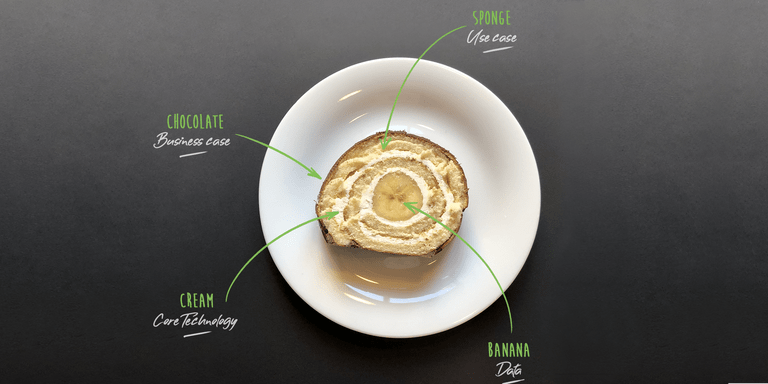While creating applications that heavily rely on data, I’ve gotten excited about many projects which soon ended up in the graveyard of good ideas.
Have you experienced this chicken-and-egg situation: no one wants to give you money to develop something until they know how good it will be, but you can’t promise anything before experimenting with the data first?
Smart Application Canvas
To get out of this impasse fast, Liip's Data team has developed a pragmatic "recipe" for data-intensive applications: the Smart Application Canvas.
It's simple and takes around 5 minutes: whenever we get started on a project idea, we ask the four questions below. And then we ask them again at every iteration to see if the answers have changed in the meantime.
It doesn't matter which of the four you start with - the trick is to have at least a rough answer to all four questions before investing more time and energy into an idea (for example, building a prototype, pitching a project proposal, etc). As long as one of these "ingredients" remain entirely blank, the project has a slim chance of succeeding.
Download this template as a PDF: template_data-application-idea_v1-0.pdf

USE - Who are the users? What job does it do well for them?
Are you looking for a way to attract more new users, keep the current ones happy, or solve an annoying issue with an existing service? Do you want to make employees' life easier or to provide better public services for citizens?
Who to ask: designers, product managers, line managers, frontline staff who are always in contact with users.
Example: customers can get immediate help 24/7 through a chatbot on our Facebook page.
Why: avoid building something that nobody wants.
BUSINESS CASE - Who might want to pay for this? How do they benefit in return?
Should the application help a person or an organization to save money and time, or to generate more income? Should it help them to achieve something that isn't simply possible with the current alternatives? Even with intangible benefits like happiness or social status, it's worth thinking of how much the current alternatives cost: this will give you an idea of how much you can afford to invest in the development of the application.
Who to ask: business people, sales people, executives who have a bird's eye view of the most pressing concerns in their organization.
Example: Online retailer XYZ can win more return customers thanks to a better after-sales service.
Why: Get someone to invest or give you a budget. The business benefits of innovative technology aren’t straightforward at first. Do you remember the time when smartphones were new and everyone thought they needed a native app just “because it’s the future”? By now it’s much easier to say whether an app is worth the cost, but what about a chatbot?
TECHNOLOGY - What is necessary for main hardware / software to get the job done?
What is possible with current technology and with how much effort? Or how can a new technology be applied in a "real-world" application? The key part of the question here is "to get the job done". When innovative technologies come along, it's tempting to try to solve too many problems at once: if there are several possible use cases, pick one. You can always change it later if you see that it doesn't work.
Who to ask: Software engineers, data scientists, hardware engineers if applicable.
Example: Facebook page, chatbot framework, natural language processing (NLP), search.
Why: Avoid a very costly, never-ending implementation.
DATA - What numbers, text, images are necessary for it to work?
Does your organization have a lot of great data but doesn't know what to do with it? What kind of data should you start collecting? Which external data sources can you use (e.g. open data)? Where is the data saved and in which format (e.g. in a database, in PDF files, in emails, ...)?
Who to ask: People who work with the data on a daily basis (e.g. Customer Care team), database specialist, data scientist.
Example: Collection of past customer questions and matching support staff answers (e.g. in emails or in an issue tracking system).
Why: What makes software "smart" is data, rather than “only” predefined rules. There might be no / not enough data, its quality might not be sufficient, or it might be difficult to access because of security or technical issues. This makes the outcome of development unpredictable. Whether our data is good enough, we can only learn by trial-and-error.
Examples
Here are a few examples of early-stage ideas by participants of the Open Data Forum 2019. The goal was to come up with applications that make use of open data.
Some canvases already carry notes on the biggest risks the idea faces, so that this can be worked on as a next step.
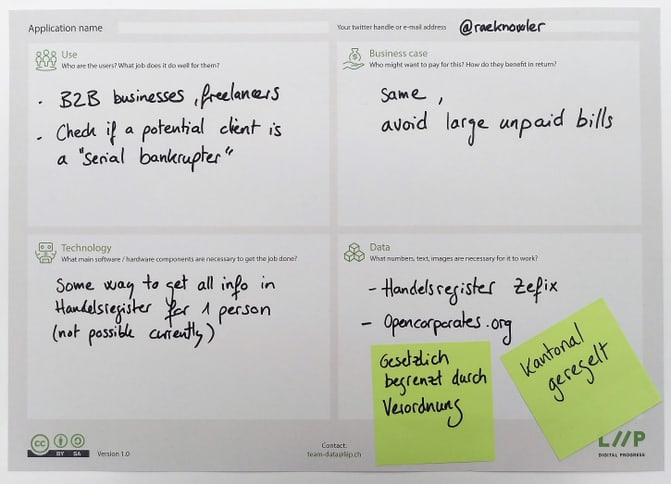
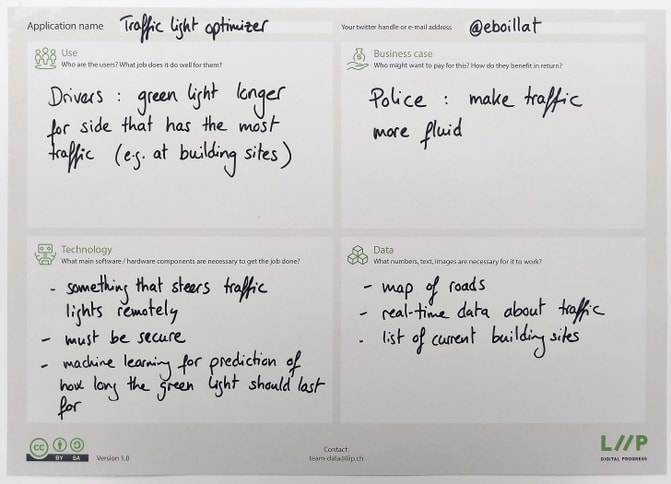
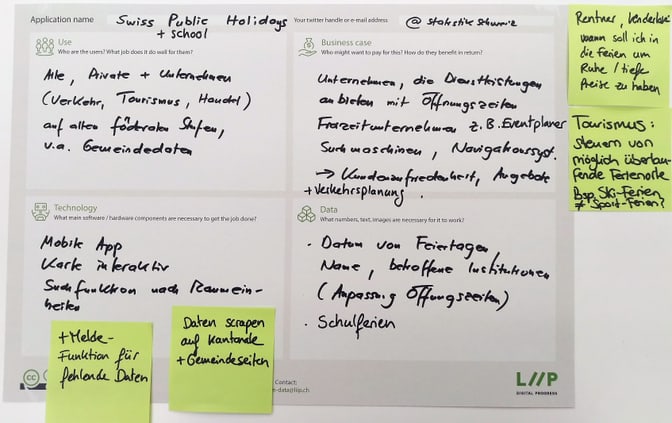
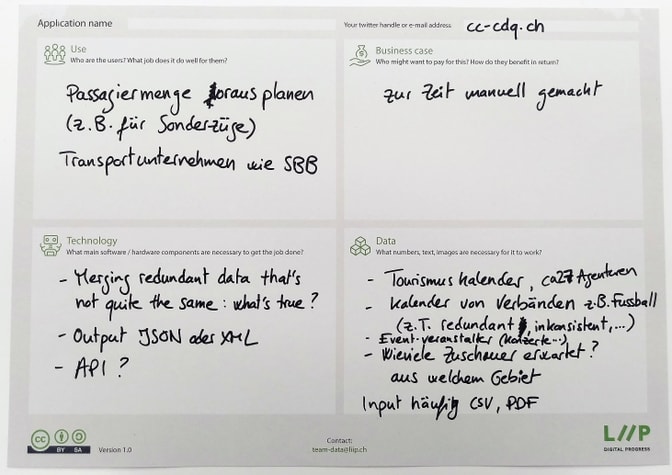
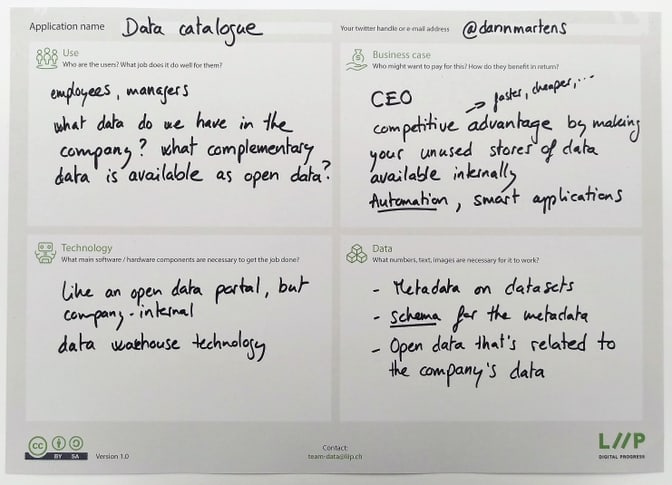
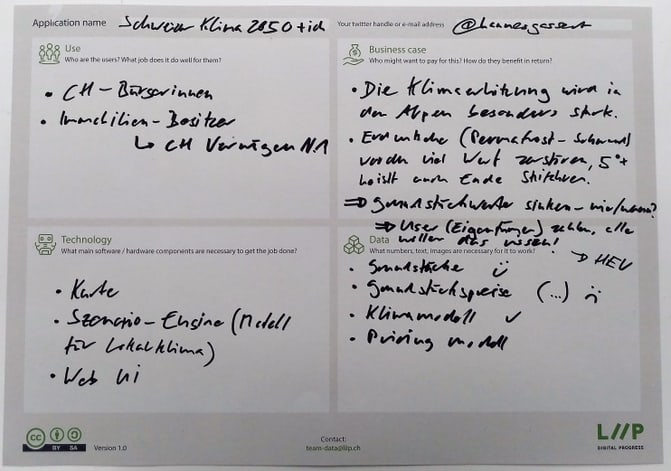
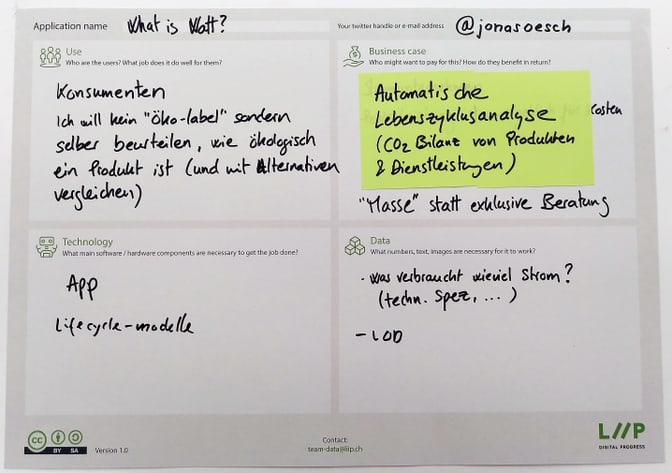
Acknowledgements
The following were sources of inspiration:
- Lean Canvas by Ash Maurya
- Business Model Canvas by Strategyzer AG
- Machine Learning Canvas by Louis Dorard
- Migros's "Bananita" roulade cake enjoyed on a particularly creative coffee break
- Our clients and colleagues in the past year with whom we've tested and refined our way of working
We're constantly working on improving our methods and would love to hear about your experience with the Smart Application Canvas. Drop us a line at team-data@liip.ch.

